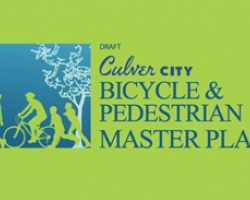Last week’s column reported that Culver City, though perhaps slightly behind the nationwide curve in moving to create a bicycle- and pedestrian-friendly environment, had made a major stride forward by adopting its Bicycle and Pedestrian Master Plan.
The city council will soon hear a proposal to amend the plan, a proposal that bicycle and pedestrian advocates fear could represent a giant step backward and possibly jeopardize the city’s chances of receiving grant money to implement the plan’s vision.
Significant grant money is available for projects only in cities, like Culver City, that have adopted a bicycle plan. A state program called the Bicycle Transportation Account (BTA) provides funds for local projects that improve safety and convenience for bicycle commuters. Under the auspices of Caltrans, grants this year totaling more than $7 million – from money raised through the Highway User’s Tax Account and the Transportation Tax Fund – are expected to be available statewide. Cities are expected to put up at least 10% of the costs of approved projects, with the remainder coming from the grants. The grant funds may be used fora variety of projects, including new bikeways serving major transportation corridors or the removal of travel barriers to potential bicycle commuters; secure bicycle parking at employment centers, park-and-ride lots and rail and transit terminals; bicycle-carrying facilities on public transit vehicles; elimination of hazardous conditions on existing bikeways; improvement and maintenance of bikeways; project planning, design, engineering and construction; and right-of-way acquisition.
According to the Caltrans Web site, to be eligible for BTA funds, a city or county “must prepare and adopt a Bicycle Transportation Plan (BTP)” that meets statutory requirements. Those requirements include maps and descriptions of existing and proposed land-use patterns, existing and proposed bikeways and end-of-trip bicycle parking facilities, connections between bicycle facilities and transit stops, and a “description of the projects proposed in the plan and a listing of their priorities for implementation.”
When the Master Plan came up for city council consideration last November, the council voted to adopt it after receiving assurances from staff that, first, the bulk of the funding for projects identified in the plan would come from competitive grants rather than the Culver City general fund and, second, that the plan was flexible enough to accommodate concerns that might arise about specific future projects.
Cyclists and pedestrians who support the current version of the Master Plan are operating a bit in the dark at this point – details of the proposed amendment to the plan had not been revealed as the News went to press. But there are reports that the amendment includes the elimination of long stretches of planned bicycle lanes on Washington Boulevard in favor of sharrows, lanes shared by cars and bicycles.
There is also a concern that the council will consider amending the Master Plan to make it easier to change than the law already provides and thereby jeopardize the city’s ability to qualify for grant money. The amendment is expected to insert language into the plan to allow the council to override approved bikeway designations in the future, based on safety and economic development considerations.
Of course, safety and economic concerns should be considered before implementing any project in the plan, and projects should be appropriately adapted to maximize benefits to the city while pursuing the vision of creating bicycle- and pedestrian-friendly travel.
In November, city staff informed the council that the plan already allows them to make appropriate project-specific amendments to adapt to the city’s needs. But a master plan that is too flexible loses the character of a plan and become a mere wish list. Cycling advocates are concerned that sources of grant money may hesitate to recognize the Master Plan as a “plan” at all if it has been amended to be too easily changed, and grantors may not be able to provide funds for any of the projects that the council only a few months ago deemed worth pursuing.
The council will consider the amendment at its March 28 meeting at Culver City City Hall at 7 p.m. The CCBC urges everyone to voice their opinions about the elimination of bicycle lanes and to ensure that the council carefully considers the ramifications of any changes so that the potential for Culver City to receive grant money is not jeopardized.
Bike Safe, Bike Smart! is a weekly column to promote responsible cycling by providing information, education and advice about riding. It’s written by members of the Culver City Bicycle Coalition (CCBC), a local chapter of the Los Angeles County Bicycle Coalition. Join them for their family bike ride the last Sunday of every month. For more information and to submit questions, write: ccbicyclecoalition@gmail.com, and visit their blog: culvercitybc.wordpress.com/.

